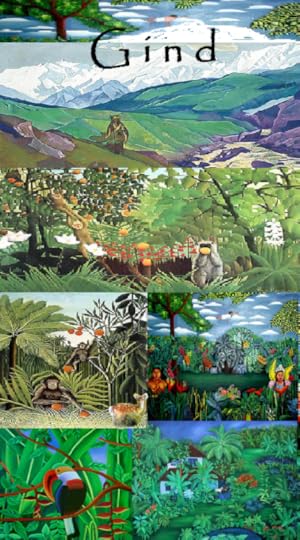Books and covers
Alan Bradley is my new favourite author. It's amazing how he simply tosses together all my favourite ingredients -- old English country house, the 50s, ghastly-funny-clever kid, awful-but-somehow-redeemed sisters, chemistry lab, books and more books, woolly vicar, a boy's school from the 20s complete with quad, gowns and mortar boards, dark woods and crumbling farms, a travelling puppet show, a WW II relic father and dark old mysteries; stirs them just so and cooks them perfectly! Judging by the reviews of his work, these are a lot of other people's favourite things too.
What surprises me are his covers. If I hadn't read all the rave reviews, but just come across the books in a shop, I doubt if I would have picked them up. They hardly convey the idea of the cozy British mystery. On the other hand, I suppose they do convey the workings of the mind of Flavia de Luce, strange child that she is.
The appeal of a cover seems to be unpredictable. For one thing, a reader's idea of a book may or may not correspond to the writer's -- the Alan Bradley books being a case in point. On top of this, the reader's and the writer's tastes change over time. For instance, Penguin's jazz themed covers for the 2000 edition of Wodehouse did not appeal to me when they first came out, but now I think they absolutely capture the soul of Wodehouse. The third angle, and a completely different one, is that of the publisher's marketing team. My publishers and I did not see eye to eye on the covers of Vanuvati and Gind.
 This was my idea of Vanuvati, but it didn't appeal to the Tulika editors. The cover they chose was nice too, but less dramatic.
This was my idea of Vanuvati, but it didn't appeal to the Tulika editors. The cover they chose was nice too, but less dramatic.
 For Gind I wanted a fantasy cover that had elements of the paintings of Murali Nagapuzha, Nicholas Roerich and Henri Rousseau, all of whose work I simply adore. I put together a concept collage of paintings of these artists, but somehow nothing came of it. But it was still a wonderful and very rewarding exercise to look for, and find, visual images from the minds of various artists that corresponded to the word pictures that I was attempting to paint. I think readers who enjoyed Gind will be interested to see the concept collage, which represents the world of Gind as I imagine it.
For Gind I wanted a fantasy cover that had elements of the paintings of Murali Nagapuzha, Nicholas Roerich and Henri Rousseau, all of whose work I simply adore. I put together a concept collage of paintings of these artists, but somehow nothing came of it. But it was still a wonderful and very rewarding exercise to look for, and find, visual images from the minds of various artists that corresponded to the word pictures that I was attempting to paint. I think readers who enjoyed Gind will be interested to see the concept collage, which represents the world of Gind as I imagine it.
Credits: Top picture is from one of Murali Nagapuzha's paintings in his Childhood series; second is Roerich's En-no-Gyoja, the Friend of Travellers; third is Henri Rousseau's Exotic Landscape; fourth row left is Rousseau's Two Monkeys in the Jungle; fourth right is Nagapuzha; and fifth row right and left are Nagapuzha again, all of these being from his 'Nature' and 'My Native' series.
What surprises me are his covers. If I hadn't read all the rave reviews, but just come across the books in a shop, I doubt if I would have picked them up. They hardly convey the idea of the cozy British mystery. On the other hand, I suppose they do convey the workings of the mind of Flavia de Luce, strange child that she is.
The appeal of a cover seems to be unpredictable. For one thing, a reader's idea of a book may or may not correspond to the writer's -- the Alan Bradley books being a case in point. On top of this, the reader's and the writer's tastes change over time. For instance, Penguin's jazz themed covers for the 2000 edition of Wodehouse did not appeal to me when they first came out, but now I think they absolutely capture the soul of Wodehouse. The third angle, and a completely different one, is that of the publisher's marketing team. My publishers and I did not see eye to eye on the covers of Vanuvati and Gind.
 This was my idea of Vanuvati, but it didn't appeal to the Tulika editors. The cover they chose was nice too, but less dramatic.
This was my idea of Vanuvati, but it didn't appeal to the Tulika editors. The cover they chose was nice too, but less dramatic. For Gind I wanted a fantasy cover that had elements of the paintings of Murali Nagapuzha, Nicholas Roerich and Henri Rousseau, all of whose work I simply adore. I put together a concept collage of paintings of these artists, but somehow nothing came of it. But it was still a wonderful and very rewarding exercise to look for, and find, visual images from the minds of various artists that corresponded to the word pictures that I was attempting to paint. I think readers who enjoyed Gind will be interested to see the concept collage, which represents the world of Gind as I imagine it.
For Gind I wanted a fantasy cover that had elements of the paintings of Murali Nagapuzha, Nicholas Roerich and Henri Rousseau, all of whose work I simply adore. I put together a concept collage of paintings of these artists, but somehow nothing came of it. But it was still a wonderful and very rewarding exercise to look for, and find, visual images from the minds of various artists that corresponded to the word pictures that I was attempting to paint. I think readers who enjoyed Gind will be interested to see the concept collage, which represents the world of Gind as I imagine it. Credits: Top picture is from one of Murali Nagapuzha's paintings in his Childhood series; second is Roerich's En-no-Gyoja, the Friend of Travellers; third is Henri Rousseau's Exotic Landscape; fourth row left is Rousseau's Two Monkeys in the Jungle; fourth right is Nagapuzha; and fifth row right and left are Nagapuzha again, all of these being from his 'Nature' and 'My Native' series.
Published on November 26, 2013 01:22
No comments have been added yet.
Read, Write and Left
Blog of a somewhat indiscriminate reader and gauche (in the French sense of course) writer.
- Harini Gopalswami Srinivasan's profile
- 71 followers



